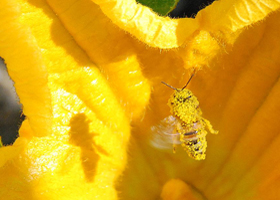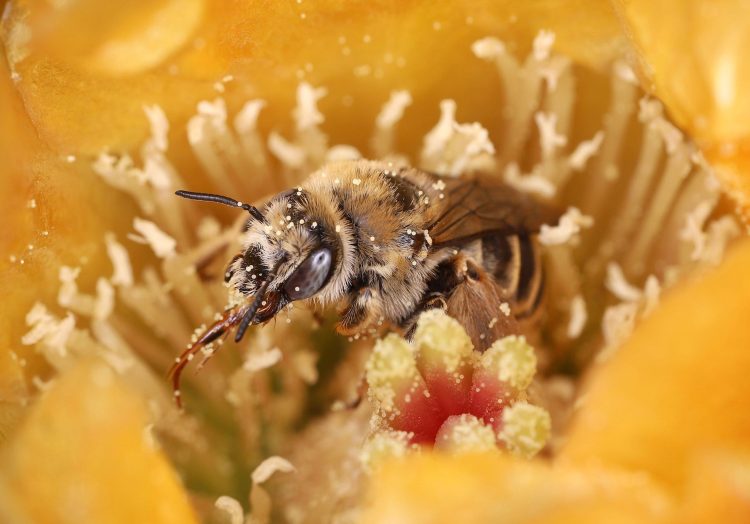Ah, the bees! Busy, buzzing, and oh-so-important to our delicate ecosystem. Bumblebees and honeybees may not be able to talk, but they certainly know how to make a sweet contribution to the world around us. From pollinating flowers to producing delicious honey, these little winged wonders are essential players in the game of life. So grab your beekeeping suit and get ready to learn all about these tiny but mighty creatures and the crucial role they play in keeping our planet healthy and thriving. Characteristics of Bumblebees and Honeybees”>
Characteristics of Bumblebees and Honeybees”>
Characteristics of Bumblebees and Honeybees
Bumblebees and honeybees may seem similar at first glance, but they actually have quite a few distinctive characteristics that set them apart.
One key difference between the two types of bees is their appearance. Bumblebees are typically larger and fluffier than honeybees, with vibrant yellow and black stripes that make them look like tiny little fuzzballs. Honeybees, on the other hand, are more slender and sleek, with subtle beige and brown stripes that give them a more sophisticated, business-like appearance.
When it comes to behavior, bumblebees are known for their more laid-back attitude. They tend to take things slow and enjoy a leisurely pace as they go about their buzzing business. Honeybees, on the other hand, are always in a rush, zipping from flower to flower like they’re late for a very important meeting with the queen.
Lastly, bumblebees are the hipsters of the insect world, preferring to live in underground burrows or abandoned rodent holes. Honeybees, on the other hand, are the social butterflies, living in busy colonies with thousands of other bees. So next time you see a bee buzzing by, take a closer look and see if you can spot the differences between these two fascinating creatures!
Importance of Pollination in Ecosystems
Everyone knows that bees are important for pollination, but did you know just how crucial they are for ecosystems? Let’s dive into the fascinating world of pollination and uncover why it’s such a big deal.
Pollination plays a vital role in maintaining biodiversity and ensuring the survival of countless plant species. Without pollinators like bees, butterflies, and birds spreading pollen from flower to flower, many plants would be unable to reproduce and would eventually disappear. Talk about a serious case of plant FOMO!
Not only do pollinators help plants reproduce, but they also contribute to the production of fruits, nuts, and seeds that humans and animals rely on for food. So, the next time you bite into a juicy apple or snack on some almonds, take a moment to thank a pollinator for their hard work.
Without pollination, ecosystems would be thrown out of balance, leading to a domino effect of negative consequences. From disrupted food chains to decreased genetic diversity, the impacts of a world without pollination would be nothing short of disastrous. So, let’s all give a round of applause to our tiny but mighty pollinator friends for keeping our world blooming and thriving!
 Differences Between Bumblebees and Honeybees”>
Differences Between Bumblebees and Honeybees”>
Differences Between Bumblebees and Honeybees
Bumblebees and honeybees may both be striped, flying insects, but that’s where the similarities end. Let’s take a closer look at the quirks and characteristics that set these busy bees apart:
- Size Matters: Bumblebees are like the football players of the bee world, bulky and robust. Honeybees, on the other hand, are the petite cheerleaders buzzing around the hive.
- Wardrobe Malfunction: Bumblebees are all about that fuzzy fashion statement, with their fluffy hair covering their bodies like a cozy sweater. Honeybees, however, prefer a more minimalist look, sporting sleek, shiny bodies.
- Flight of the Bumblebee: Bumblebees are the daredevils of the bee world, flying in windy conditions and even in the rain. Honeybees are a bit more high-maintenance, preferring calm weather for their delicate flights.
So the next time you spot a buzzing bee in your garden, take a closer look to determine if it’s a bumbling bumblebee or a honey-sweet honeybee. Each has its own unique traits that make them essential players in the grand symphony of nature!

Role of Bumblebees and Honeybees in Food Production
Who would have thought that these tiny, buzzing insects could play such a crucial role in our food production? Well, bumblebees and honeybees are the unsung heroes of the agricultural world, tirelessly flitting from flower to flower, pollinating crops and ensuring that our plates are always full.
Without these hardworking bees, we would be left with barren fields and wilted crops. So, next time you see a bee buzzing around your garden, make sure to thank them for their invaluable service!
It’s not just about producing honey, although that is definitely a sweet bonus. These industrious insects are responsible for pollinating a whopping 75% of the fruits, nuts, and vegetables that we consume on a daily basis. Imagine a world without juicy strawberries, crunchy almonds, or ripe tomatoes – horrifying, right?
So, the next time you enjoy a fresh salad or a delicious fruit smoothie, remember to raise a toast to our fuzzy little friends, the bumblebees and honeybees, for all that they do to keep our plates and bellies full!

Threats to Bumblebee and Honeybee Populations in Ecosystems
Bumblebees and honeybees face a myriad of threats in ecosystems that could potentially wipe out their populations faster than you can say “buzz off!” Here are some of the most menacing dangers:
- **Pesticides:** These chemicals are like the bees’ version of a villain, lurking in the shadows waiting to strike. Unfortunately, many pesticides are harmful to our fuzzy friends and can cause serious damage to their populations.
- **Loss of Habitat:** Imagine coming home one day only to find that your cozy little hive has been bulldozed to make way for a shopping mall. That’s the harsh reality for many bees as their natural habitats are destroyed by development and urbanization.
- **Climate Change:** Bees are feeling the heat – quite literally – as rising temperatures and unpredictable weather patterns wreak havoc on their delicate ecosystems. It’s like they’re living in a never-ending episode of a reality show called “Survivor: Bee Edition.”
So, what can we do to save our beloved bumblebees and honeybees from these formidable foes? It’s time to take action and protect these essential pollinators before it’s too late. Together, we can ensure that bees continue to play their vital role in maintaining the balance of our ecosystems – and maybe even throw them a little “bee party” to show our appreciation!
Conservation Efforts to Protect Bumblebees and Honeybees
Bumblebees and honeybees are some of our hardest workers in the world of pollination, buzzing around from flower to flower, ensuring the plants we rely on for food continue to thrive. However, these precious insects are facing numerous threats, including habitat loss, pesticide use, and climate change.
But fear not, for there are plenty of conservation efforts in place to protect our buzzing buddies! From creating bee-friendly gardens to advocating for stricter pesticide regulations, there are many ways we can all do our part to help save these important pollinators.
One fun way to get involved in bumblebee and honeybee conservation is to become a beekeeper yourself! Not only will you get to enjoy the sweet rewards of harvesting your own honey, but you’ll also be creating a safe haven for these vital insects.
So let’s all band together and make a bee-line towards saving our bumblebee and honeybee friends! With a little bit of effort, we can ensure these pollinators continue to thrive for generations to come.
Effects of Declining Bee Populations on Ecosystems
Bees are disappearing faster than snacks at a potluck party! But the buzz about their declining populations goes beyond just honey production. These tiny pollinators play a crucial role in ecosystems, and their disappearance could have some serious consequences.
First off, imagine a world without avocados. **Gasp**. Bees are responsible for pollinating a large number of fruits and vegetables, including avocados, apples, and almonds. Without them, we could say goodbye to guacamole, apple pie, and almond milk. Who knew these tiny creatures were responsible for so many of our favorite snacks?
Secondly, bees are like the unpaid interns of the plant world – they work tirelessly to pollinate flowers, ensuring the survival of countless plant species. Without bees, many plants would struggle to reproduce, leading to a decline in biodiversity. It’s like a real-life soap opera where the star-crossed lovers (plants and bees) are torn apart, and the supporting cast (other species) suffers the consequences.
Lastly, bees are the ultimate winged matchmakers, bringing plants together for some plant-on-plant action. Their pollination services help create new habitats for a variety of organisms, from insects to birds. Without bees, these ecosystems could collapse, leaving many species without a place to call home. Talk about a bee-mergency!
FAQs
What makes bumblebees and honeybees such essential contributors to the ecosystem?
Bumblebees and honeybees play a crucial role in pollinating plants, which is essential for the reproduction of many flowering plants. Without bees, many fruits and vegetables would struggle to grow, leading to a shortage of food for humans and other animals.
How do bumblebees and honeybees differ in their pollination techniques?
Bumblebees are known for their “buzz pollination” technique, where they vibrate their bodies at a specific frequency to release pollen from flowers. Honeybees, on the other hand, use their long tongues to collect nectar and inadvertently transfer pollen as they move from flower to flower.
Do bumblebees and honeybees face any threats to their populations?
Unfortunately, both bumblebees and honeybees are facing threats from habitat loss, pesticide use, and climate change. These factors have led to declining bee populations around the world, which is concerning for the environment and agriculture.
How can we help support bumblebees and honeybees in their important role in the ecosystem?
One way to support bees is to plant bee-friendly flowers in your garden or community spaces. Avoiding the use of pesticides and providing nesting habitats, such as bee hotels, can also help create a safe environment for bees to thrive.
What are some interesting facts about bumblebees and honeybees that people may not know?
Did you know that bumblebees are capable of flying at high altitudes, even reaching the summit of Mount Everest? And honeybees communicate with each other by performing elaborate “waggle dances” to share information about food sources.
—
Don’t Bee Fooled!
Buzzing through meadows and fields, bumblebees and honeybees may seem like small insects, but their impact on our ecosystem is nothing to take lightly. These friendly pollinators are essential contributors in maintaining a healthy environment for all living creatures. So, next time you see a bee buzzing by, remember to thank them for all their hard work. After all, without them, our world would be a lot less sweet!






